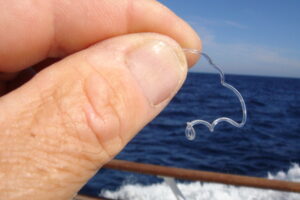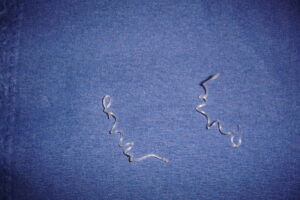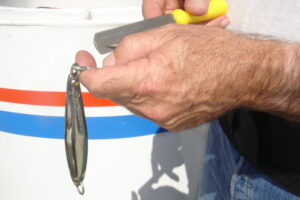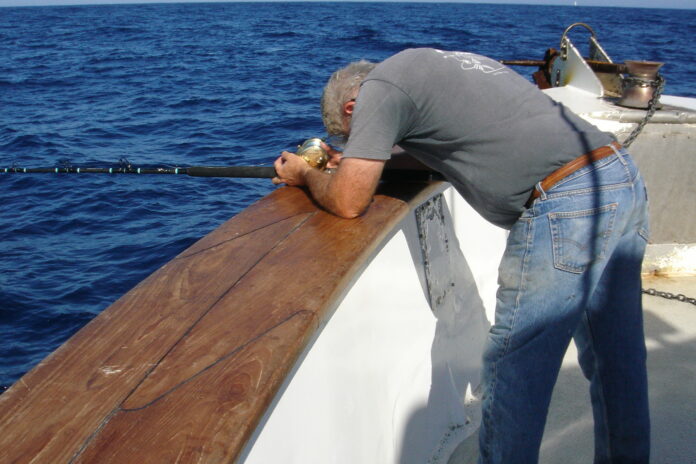BY LARRY BROWN
There are so many ways we handicap ourselves on fishing trips. Here are five stupid things I see all the time. I call it “angler error.” Just eliminate these five mistakes and you will almost assuredly hook and then land more fish.
- Using bad baits
Bait selection and presentation are critical. Professional party and charter boat captains agree, “The single biggest problem keeping anglers from hooking more fish is not selecting a good bait and not casting well; not getting their bait out to where the fish are.”
Always select the best possible bait. All predator fish expect to encounter strong, healthy anchovies, sardines or mackerel in their wild environment without hooks and line dangling from their bodies. The top anglers select only the strongest, healthiest baits in the bait tank, carefully and gently scoop them and caress them in their hand while they carefully hook them through the nose, across the shoulder or just under the anal fins in the most noninvasive way possible.
Look for the lightest-colored sardine, with boldly defined round black spots on its back. It is usually swimming beneath the others and most erratically when it notices your hand or net. Don’t do a death grip on the bait and once it is on the hook release it back into the bait tank immediately. Then pinch the line 10 inches up from the hook and walk your bait to the rail where you will gently cast it into the water as quickly as possible. If you see a lot of scales on your rod butt, you are man handling your bait.
Solution: Master bait selection
- Not being able to cast or control your bait
So, you have the perfect bait. Now you need to execute the perfect cast and control your bait. The chum is landing 30 feet off the downwind corner of the stern. You see fish boiling on the chum. Crew members are yelling “Boil on the chum!” If you can cast 30 feet and land your bait gently in the same zone where the chum is landing, it frequently results in an instant bite. If you can’t cast and just drop your bait over the rail, chances are your poor bait will dart under the boat for protection. You likely won’t get bit, there’s a good chance you will be in a tangle and if you do get bit, you will likely lose the fish in the props or rudders.
Knowing when to nose, collar or butt hook baits will also increase your success. Knowing when to fly-line versus using a sliding sinker is also important. Without a very detailed article on these techniques, my best advice is to be hyper aware of what technique is working “right now” and convert immediately. Listen to and watch your fellow anglers who are hooking fish and ask your crew member for their advice.
Using the perfect bait with a perfect presentation will dramatically increase your hookup percentages.
Solution: Learn how to cast a small bait 30’ and practice at your local park
- Tying knots that fail
Curly Q’s and half circles are evidence of bad knots. A curly Q means the knot unraveled and a tiny half circle means the knot cut itself on the eye of the hook. Bad knots lose fish and they are very easy to avoid. If you have ever experienced a knot failure, I hope you are open to learning a new knot, or how to tie your knot precisely. Just learn one good knot for each application and practice it for 5 minutes every month through the non-fishing season. Four knots for 4 applications:

- Mono or fluoro to the hook or jig — I use the Spangler.
- Mono-to-fluoro connection — I use the Seaguar.
- Spectra to mono or fluoro connection — I use a double Albright.
- Dropper loop — I use the Surgeon’s Loop.
Don’t be tempted to learn and practice five different knots for the same application. All the good knots work well if tied perfectly and all the good knots fail when tied imperfectly. Only confusion and failure result when you know five knots marginally but none perfectly. All of the crew members and fishing pros have their favorite knots, and they never fail because their knots are tied perfectly. Types of knots (or crimping versus knots) are personal preference. They all work when done correctly and all fail when done incorrectly.
Solution: Learn 4 basic knots perfectly – practice 5 minutes every month
- Using old or bad line
Oh my!, you spend thousands of dollars on a trip and use old, cheap or damaged line. Bad line is a major impediment to hooking fish and bad line is a major cause for losing fish once they are hooked. Monofilament line has memory, and the tight coils it develops in just a

week create significantly more drag in the water — picture a giant slinky in the water. Coiled line is more difficult to cast, it reduces the perfection of the bait presentation and it makes a solid hook-set more difficult. Long casts are frequently necessary to get your bait to boiling fish, into the current or away from the boat. Have you ever seen fish boiling on the chum but ignoring hooked bait? The increased drag of coiled line on your live bait will weigh it down, slow it down and make it appear unnatural. Finally, the giant slinky makes solid hook-sets more difficult as the line needs to be straight and tight to penetrate the bony jaws of many gamefish. Old monofilament line on your reel is bad even if it has never been used. You should also always check your line for nicks, abrasion and other damage that can weaken your line and quickly replace it to avoid losing the next big fish you hook.
Fluorocarbon usually gets bit better than mono and the coiling can be straightened by pulling the line under pressure. I use a 15-foot topshot of Seaguar Gold fluorocarbon on all my bait rigs tied directly to my braid.
Solution: Use Fresh, high-quality line.
- Not listening to the crew
The crew is on the water every day, and they want you to catch fish. They know what works best and what does not. But, believe it or not, a lot of anglers just don’t listen to or follow the crew’s advice. I’ve heard salty old anglers say to young deck hands, “I’ve been fishing since before you were born.” These are often the guys making the same mistakes for 30 years. It is also very frustrating for the crew after telling passengers multiple times what works to see them still doing it their way. The crew knows the proper drag setting, where’s best to toss in, the best bait in the tank, how to do the tuna shuffle and stay out of tangles. Ask them for help. Listen to them and you will hook and land more fish.
Solution: ALWAYS, listen to your deckhands and follow their advice, ALWAYS.
Bonus Time: Here are some bonus tips which will continue to improve your hookup and landing success.
Be prepared – Have the right gear ready to go at the right time. Be sure to be ready to get in the water when the captain says go.
Setting the hook – Learn how to set the hook when using J-Hooks and circle hooks. Always get tight before lifting your rod.
Use good quality, sharp hooks – Sharpen your hooks and check them frequently. A razor-sharp hook is more likely to grab and hold a fish. An ultra-sharp hook is also less invasive and damaging to the bait, penetrating the nose, shoulder or belly of the bait with less trauma.
Avoid or reduce tangles and try getting out of them ASAP – If your baits are tangled, chances are you won’t get bit, and if you do get bit the odds of landing the fish drops dramatically. If your fish are tangled, your odds of landing both or all fish decrease substantially. Tangles are avoidable much of the time. You can avoid tangles by being aware of where your bait is and where your fish is and by keeping them in front of you all the time.
Upgrade your gear and dispose of the old stuff – Sell or donate rods and reels you haven’t used in five years. They are taking up valuable space and if you haven’t used them in five years, you likely never will. The new 2- and 3-speed reels and new technology rods just work better, are smoother, cast better, are more powerful and more reliable.

Set and reset drags correctly – Be sure to set your drags correctly before your first cast and to reset them every morning of a fishing trip. Ask a crew member to set your drag and pull on it to learn what 10 pounds, 20 pounds, etc. feels like so you can do it next time without help.
Maintain reels and rods in perfect condition– Saltwater, dirt, old grease and normal wear and tear of drags and moving parts are all problematic for reels. A sticky drag or bad free spool are huge impediments for success. Service your reels just like your car or body. Check your ceramic guides for cracks which can cut line.
Reduce your fight time by 20% – The longer you fight your fish, the more can go wrong. Having the drag set properly is critical. Trust your drag and when the fish is straight up and down it’s time to add pressure by going past strike on your lever drag, tightening the star drag or aiding the drag by pushing the line against the hypolon on the rod. Very few hooks pull because of too much pressure. Excess time in the water can result in losing your fish to many factors: sharks, sea lions, tangles, kelp, rocks, the bottom of the boat — including the rudder or props — a weak point in the line or being cut off by a freshly-hooked fish.
Learn, Practice and Bring a Positive Attitude – Keep learning, practice and bring a positive attitude onto the boat. You will catch more fish and have more fun.
Conclusion
So even though the Love Story movie taught us, “It’s better to have loved and lost than never to have loved at all,” it’s even better to love and keep the girl. In fishing, it’s better to hook the fish, land the fish and eat the fish. Follow these lessons and you will do more of all of the above.



